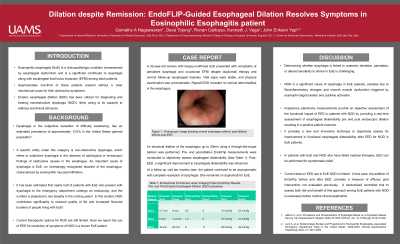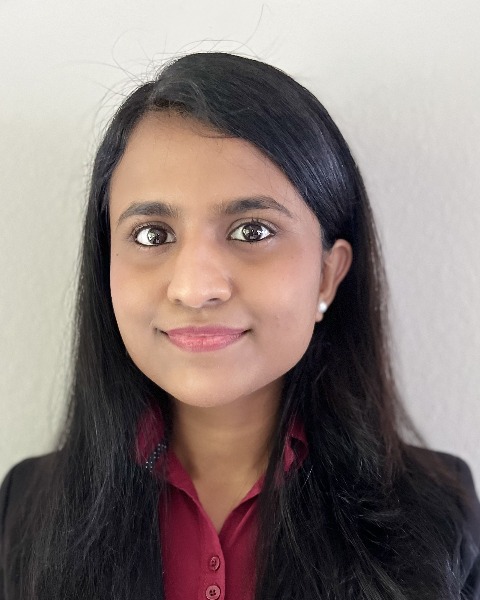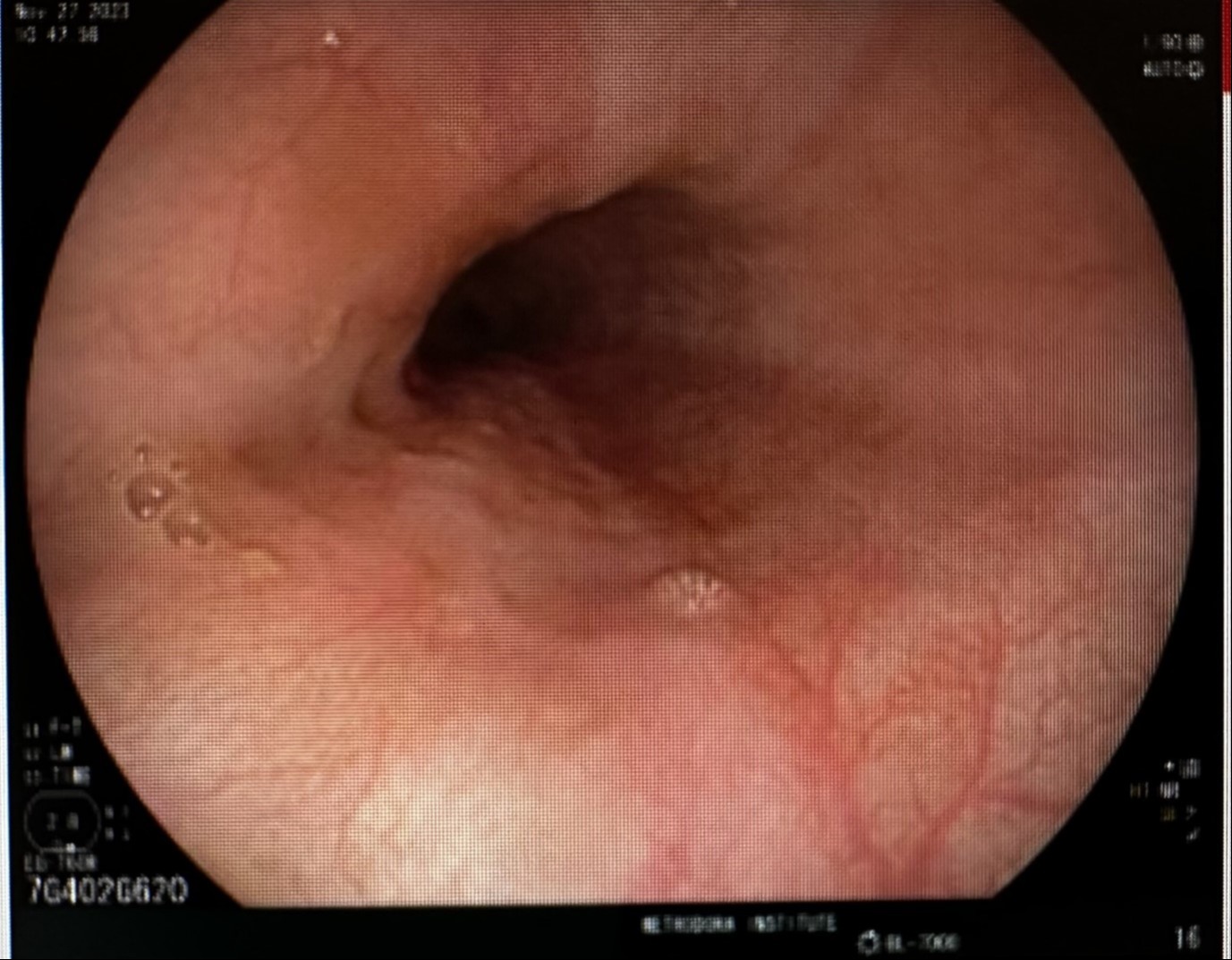Tuesday Poster Session
Category: Esophagus
P4023 - Dilation Despite Remission: Endoflip-Guided Esophageal Dilation Resolves Symptoms in Eosinophilic Esophagitis Patient
Tuesday, October 29, 2024
10:30 AM - 4:00 PM ET
Location: Exhibit Hall E

Has Audio

Gomathy A. Nageswaran, MBBS
University of Arkansas for Medical Sciences
Little Rock, AR
Presenting Author(s)
Gomathy A. Nageswaran, MBBS1, Deva Christine T. Tojong, MD2, Ronan Calibuso, MD3, Kenneth Vega, MD, FACG2, John Erikson Yap, MD, MBA, FACG4
1University of Arkansas for Medical Sciences, Little Rock, AR; 2Medical College of Georgia at Augusta University, Augusta, GA; 3Jersey City, NJ; 4Metrodora Institute, West Valley City, UT
Introduction: Eosinophilic esophagitis (EoE) is now a significant cause of dysphagia and esophageal food bolus impaction (EFBI) in adults. Nearly a third of these patients have no mechanical cause of obstructive symptoms. Additionally, younger patients are likely to have more inflammatory than fibrostenotic disease. Empiric esophageal dilation (EED) is a diagnostic and therapeutic procedure for nonobstructive dysphagia (NOD), likely by disrupting occult strictures that are undetected at endoscopy. We present a case of an EoE patient with dysphagia who underwent EED treatment, resulting in sustained improvement of obstructive symptoms.
Case Description/Methods: A 32-year-old woman with biopsy-confirmed EoE presented with intractable dysphagia and occasional EFBI despite dupilumab therapy and normal follow-up esophageal biopsies. Vital signs were stable and physical examination was unremarkable. Repeat EGD revealed no esophageal luminal abnormalities. Impedance planimetry measurements were performed during EGD to assess esophageal distensibility before the EED (Table 1). EED up to 20mm was then performed using a through-the-scope balloon, with no post-dilation effect, and followed by immediate post-dilation impedance planimetry to reassess distensibility (Table 1). Post-EED, a significant improvement in esophageal distensibility was observed. At follow-up ten months post-intervention, the patient reported no further dysphagia episodes on a normal diet while continuing maintenance dupilumab therapy for EoE.
Discussion: Determining whether dysphagia is linked to anatomic deviation, peristalsis, or altered sensitivity to stimuli in EoE is challenging. NOD is a significant cause of dysphagia in EoE patients, possibly due to fibroinflammatory changes and smooth muscle dysfunction triggered by eosinophil degranulation and cytokine activation. In patients with EoE and NOD who have failed medical therapies, EED may be performed for symptomatic relief. Current data on EED use in NOD is still inconclusive. Impedance planimetry measurements provide an objective assessment of the functional impact of EED in patients with NOD by providing a real-time assessment of esophageal distensibility pre and post-endoscopic dilation, resulting in a positive patient outcome. In addition, a randomized controlled trial to assess both the risks and benefits of this approach among EoE patients with NOD is necessary before routine clinical application.

Note: The table for this abstract can be viewed in the ePoster Gallery section of the ACG 2024 ePoster Site or in The American Journal of Gastroenterology's abstract supplement issue, both of which will be available starting October 27, 2024.
Disclosures:
Gomathy A. Nageswaran, MBBS1, Deva Christine T. Tojong, MD2, Ronan Calibuso, MD3, Kenneth Vega, MD, FACG2, John Erikson Yap, MD, MBA, FACG4. P4023 - Dilation Despite Remission: Endoflip-Guided Esophageal Dilation Resolves Symptoms in Eosinophilic Esophagitis Patient, ACG 2024 Annual Scientific Meeting Abstracts. Philadelphia, PA: American College of Gastroenterology.
1University of Arkansas for Medical Sciences, Little Rock, AR; 2Medical College of Georgia at Augusta University, Augusta, GA; 3Jersey City, NJ; 4Metrodora Institute, West Valley City, UT
Introduction: Eosinophilic esophagitis (EoE) is now a significant cause of dysphagia and esophageal food bolus impaction (EFBI) in adults. Nearly a third of these patients have no mechanical cause of obstructive symptoms. Additionally, younger patients are likely to have more inflammatory than fibrostenotic disease. Empiric esophageal dilation (EED) is a diagnostic and therapeutic procedure for nonobstructive dysphagia (NOD), likely by disrupting occult strictures that are undetected at endoscopy. We present a case of an EoE patient with dysphagia who underwent EED treatment, resulting in sustained improvement of obstructive symptoms.
Case Description/Methods: A 32-year-old woman with biopsy-confirmed EoE presented with intractable dysphagia and occasional EFBI despite dupilumab therapy and normal follow-up esophageal biopsies. Vital signs were stable and physical examination was unremarkable. Repeat EGD revealed no esophageal luminal abnormalities. Impedance planimetry measurements were performed during EGD to assess esophageal distensibility before the EED (Table 1). EED up to 20mm was then performed using a through-the-scope balloon, with no post-dilation effect, and followed by immediate post-dilation impedance planimetry to reassess distensibility (Table 1). Post-EED, a significant improvement in esophageal distensibility was observed. At follow-up ten months post-intervention, the patient reported no further dysphagia episodes on a normal diet while continuing maintenance dupilumab therapy for EoE.
Discussion: Determining whether dysphagia is linked to anatomic deviation, peristalsis, or altered sensitivity to stimuli in EoE is challenging. NOD is a significant cause of dysphagia in EoE patients, possibly due to fibroinflammatory changes and smooth muscle dysfunction triggered by eosinophil degranulation and cytokine activation. In patients with EoE and NOD who have failed medical therapies, EED may be performed for symptomatic relief. Current data on EED use in NOD is still inconclusive. Impedance planimetry measurements provide an objective assessment of the functional impact of EED in patients with NOD by providing a real-time assessment of esophageal distensibility pre and post-endoscopic dilation, resulting in a positive patient outcome. In addition, a randomized controlled trial to assess both the risks and benefits of this approach among EoE patients with NOD is necessary before routine clinical application.

Figure: Endoscopic image showing normal esophagus without post-dilation effects post-EED
Note: The table for this abstract can be viewed in the ePoster Gallery section of the ACG 2024 ePoster Site or in The American Journal of Gastroenterology's abstract supplement issue, both of which will be available starting October 27, 2024.
Disclosures:
Gomathy Nageswaran indicated no relevant financial relationships.
Deva Christine Tojong indicated no relevant financial relationships.
Ronan Calibuso indicated no relevant financial relationships.
Kenneth Vega indicated no relevant financial relationships.
John Erikson Yap indicated no relevant financial relationships.
Gomathy A. Nageswaran, MBBS1, Deva Christine T. Tojong, MD2, Ronan Calibuso, MD3, Kenneth Vega, MD, FACG2, John Erikson Yap, MD, MBA, FACG4. P4023 - Dilation Despite Remission: Endoflip-Guided Esophageal Dilation Resolves Symptoms in Eosinophilic Esophagitis Patient, ACG 2024 Annual Scientific Meeting Abstracts. Philadelphia, PA: American College of Gastroenterology.
